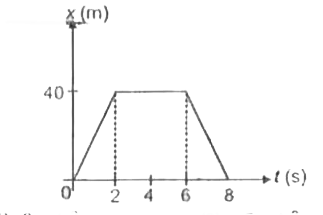The position of particle moving along the x-axis veries with time t as x=6t−t2+4. Find the time-interval during which the particle is moving along the positive x-direction.
To find the time interval during which the particle is moving along the positive x-direction, we need to analyze the position function of the particle given by:
x(t)=6t−t2+4
Step 1: Find the velocity of the particle
The velocity v(t) of the particle is the derivative of the position function with respect to time t.
v(t)=dxdt=ddt(6t−t2+4)
Calculating the derivative:
v(t)=6−2t
Step 2: Determine when the particle is moving in the positive x-direction
The particle is moving in the positive x-direction when the velocity v(t) is greater than zero.
v(t)>0⟹6−2t>0
Step 3: Solve the inequality
To find the time intervals, we solve the inequality:
6−2t>0
Rearranging gives:
6>2t⟹t<3
Step 4: Identify the time interval
Since the velocity is a linear function and it changes sign at t=3, we need to check the behavior of the velocity:
- For t<3, v(t)>0 (the particle moves in the positive x-direction).
- For t=3, v(t)=0 (the particle stops).
- For t>3, v(t)<0 (the particle moves in the negative x-direction).
Thus, the time interval during which the particle is moving along the positive x-direction is:
t∈(0,3)
Final Answer
The particle is moving along the positive x-direction during the time interval t∈(0,3).
---
The velocity v(t) of the particle is the derivative of the position function with respect to time t.
The particle is moving in the positive x-direction when the velocity v(t) is greater than zero.
To find the time intervals, we solve the inequality:
Since the velocity is a linear function and it changes sign at t=3, we need to check the behavior of the velocity:
- For t=3, v(t)=0 (the particle stops).
- For t>3, v(t)<0 (the particle moves in the negative x-direction).
The particle is moving along the positive x-direction during the time interval t∈(0,3).
Topper's Solved these Questions
Similar Questions
Knowledge Check
- Question 1 - Select One or More
Position of particle moving along x-axis is given as x=2+5t+7t2 then calculate :
AVelocity (i.edxdt) of particleBInitial velocity(i.edxdt att=0)CVelocity at t=2secDAccleration(i.ed2xdt2) of particle - Question 2 - Select One
The position of a particle moving along x-axis is given by x=10t−2t2. Then the time (t) at which it will momentily come to rest is
AZeroB2.5 sC5 sD10 s - Question 3 - Select One
Position of a particle moving along a straight line is given by x=2t2+t . Find the velocity at t = 2 sec.
A3B6C4D9
(a) The position of a particle moving along the x-axis depends on the time according to equation. x=(3t2−t3) m. At what time does the particle reaches its maximum x-position?
(b) What is the displacement during the first 4s.View SolutionThe position of a particle moving along the y-axis is given as y=3t2−t3 where y is in , metres and t is in sec.The time when the particle attains maximum positive y position will be
View SolutionThe x -coordinate of a particle moving along x -axis varies with time as x=6-4t+t^(2), where x in meter and t in second then distance covered by the particle in first 3 seconds is
View SolutionPosition of a particle moving along x-axis is given by x=2+8t−4t2. The distance travelled by the particle from t=0 to t=2 is:-
View SolutionThe position (x) of a particle moving along x - axis veries with time (t) as shown in figure. The average acceleration of particle in time interval t = 0 to t = 8 s is
 View Solution
View Solution

